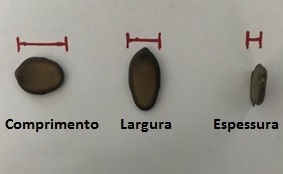Morphometry and seed beneficiation of Schizolobium parahyba (Vell.) Blake var. parahyba
DOI:
https://doi.org/10.20873/jbb.uft.cemaf.v8n4.hanzenKeywords:
guapuruvú, seed classification, sieve retentionAbstract
The objective of this work was to evaluate morphometry and seed beneficiation of Schizolobium parahyba. Were used seeds from the three tree matrices located in a ciliary domain area in the municipality of Medianeira – PR. Casually separated four repetitions from 100 seeds. Circular sieve sieves were used, with perfurations of 14 mm to 18 mm, and oblong sieves, with perfurations of 4 x 22 mm to 5 x 22 mm. The test took place so that the seeds were arranged on the sieves in descending order and subjected to manual agitation. After obtaining morphometric data, descriptive statistical procedures have been applied and histograms were built of frequency distribution and class histograms according to the type and size of the sieve. The proportions were tested with Qui-square test at the level of 5% of error probability in the proportion of observed and expected seeds within the class intervals. The average morphometric and mass parameters, as well as the uniformity of the retained seeds as a function of drill and sieve type, were submitted to variance analysis and when differences of differences were compared by Dunnett test at 5% of error probability. The results obtained indicated the circular sieves as the best for processing of guapuruvú seeds with the fact that the best basis for separation was width.
References
Antunes LEC, Picolotto L, Vignolo GK, Goncalves MA. Influência do substrato, tamanho de sementes e maturação de frutos na formação de mudas de pitangueira. Revista Bra-sileira de Fruticultura, v. 34, n. 4, p. 1216-1223, 2012.
Bewley JD, Bradford KJ, Hilhorst HWM, Nonogaki H. Seeds: physiology of development, germination and dor-mancy. 3 Ed. New York: Springer, 392p. 2013.
Biruel RP, Paula RC, Aguiar IB. Germinação de sementes de Caesalpinia leiostachya (Benth.) Ducke (pau-ferro) classifi-cadas pelo tamanho e pela forma. Revista Árvore, v.34, n.2, p.197-204, 2010. http://dx.doi.org/10.1590/S0100-67622010000200001
Carvalho PER. Guapuruvu – Taxonomia e Nomenclatura. Colombo: Embrapa Florestas, 10p. 2005.
Cruz ED, Carvalho JEU. Biometria de frutos e sementes e germinação de curupixá (Micropholis cf. venulosa Mart. & Eichler - Sapotaceae). Acta Amazonica, v.33, n.3, p.389-398, 2003. http://dx.doi.org/10.1590/S0044-59672003000300005
Dranski JAL, Sonda ET, Demarchi Junior JC. Tamanho de sementes e fertilizante de liberação controlada na produção de mudas de Schizolobium parahyba [(Vell.) S. F. Blake)]. Biotemas, v.32, n.2, p.23-31, 2019. https://doi.org/10.5007/2175-7925.2019v32n2p23
Freire JM, Piña-Rodrigues FCM, Santos ALF, Pereira MB. intra-and inter-population variation in seed size and dorman-cy in Schizolobium parahyba (Vell.) Blake in the Atlantic Forest. Ciência Florestal, v.25, n.4, p.897-907, 2015. http://dx.doi.org/10.5902/1980509820592
Gonzalo DAD, Garcia RJF, Gomes EPC. Avaliação de área recuperada sobre cava de areia em São Paulo, SP, Brasil. Hoehnea, v.42, n.4, p.695-701, 2015. http://dx.doi.org/10.1590/2236-8906-15/RAD/2015
Gusmão E, Vieira FA, Júnior EMF. Biometria de frutos e endocarpos de murici (Byrsonima verbascifolia Rich. Ex A. Juss.). Revista Cerne, v.12, n.1, p.84-91, 2006.
Malavasi UC, Malavasi MM. Influência do tamanho e do peso da semente na germinação e no estabelecimento de espécies de diferentes estágios da sucessão vegetal. Floresta e Ambi-ente, v.8, n.1, p.211-215, 2001.
Nitsche PR, Caramori PH, Ricce WS,Pinto, LFD. Atlas climá-tico do estado do Paraná. Londrina: Instituto Agronômico do Paraná, 210p. 2019.
Pagliarini MK, Nasser MD, Nasser FACM, Cavichioli JC, Castilho RMM. Influência do tamanho de sementes e subs-tratos na germinação e biometria de plântulas de jatobá. Tec-nologia e Ciência Agropecuária, v.8, n.5, p.33-38, 2014.
Peske ST, Labbé LMB. Beneficiamento de sementes. In: Peske ST, Villela FA, Meneghello GE. Sementes: funda-mentos científicos e tecnológicos. 3. Ed. Pelotas: Ed. Uni-versitária/UFPEL, p.423-480. 2012.
Pietrobom RCV, Oliveira DMT. Morfoanatomia e ontogênese do pericarpo de Schizolobium parahyba (Vell.) Blake (Fa-baceae, Caesalpinioideae). Revista Brasileira de Botânica, v.27, n.4, p.767-779, 2004. http://dx.doi.org/10.1590/S0100-84042004000400015
Resende LA, Pinto LVA. Emergência e desenvolvimento de espécies nativas em área degradada por disposição de resí-duos sólidos urbanos. Revista Agrogeoambiental, Pouso Alegre, v.5, n.1, p.37-48, 2013.
Sigmaplot. Scientific Graphing Software: Version 12.0. San Rafael: Jandel Corporation, 2011.
Silva KB, Bruno RLA, Melo PAFR. Qualidade fisiológica de sementes de Sideroxylon obtusifolium (Roem. & Schult.) Penn. classificadas pelo tamanho. Revista Brasileira de Bio-ciências, v.13, n.1, p.1-4, 2015.
Sturges HA. The choice of a class interval. Journal of the American Statistical Association, v.21, n.153, p.65-66, 1926. https://dx.doi.org/10.1080/01621459.1926.10502161
Trianoski R, Iwakiri S, Matos JLM, Prata JG. Avaliação de espécies alternativas de rápido crescimento para produção de painéis de madeira aglomerada de três camadas. Scientia Fo-restalis, v.39, n.89, p.97-104, 2011.
Tsakaldimi M, Ganatsas P, Jacobs DF. Prediction of planted seedling survival of five Mediterranean species based on initial seedling morphology. New Forests, v.44, n.3, p.327-339, 2013. https://doi.org/10.1007/s11056-012-9339-3

Downloads
Published
How to Cite
Issue
Section
License
Copyright (c) 2024 - Journal of Biotechnology and Biodiversity

This work is licensed under a Creative Commons Attribution 4.0 International License.
Authors who publish with this journal agree to the following terms:
Authors retain copyright and grant the journal right of first publication with the work simultaneously licensed under a Creative Commons Attribution License (CC BY 4.0 at http://creativecommons.org/licenses/by/4.0/) that allows others to share the work with an acknowledgement of the work's authorship and initial publication in this journal.
Authors are able to enter into separate, additional contractual arrangements for the non-exclusive distribution of the journal's published version of the work (e.g., post it to an institutional repository or publish it in a book), with an acknowledgement of its initial publication in this journal.
Authors are permitted and encouraged to post their work online (e.g. in institutional repositories or on their website) prior to and during the submission process, as it can lead to productive exchanges, as well as earlier and greater citation of published work (Available at The Effect of Open Access, at http://opcit.eprints.org/oacitation-biblio.html).


